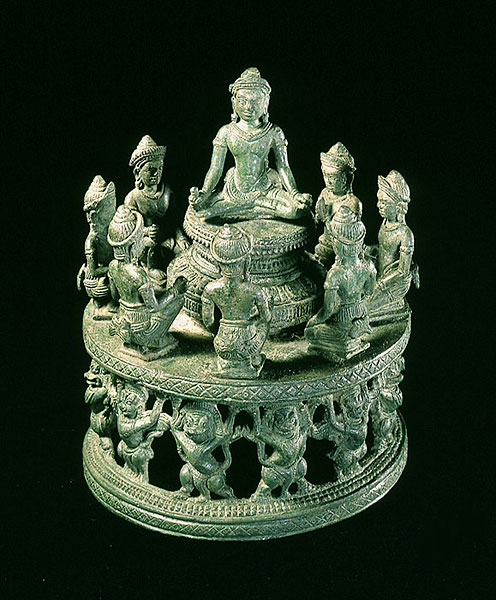previous image || Tantric Hinduism in Khmer Culture || next image
Chandra Mandala
Cambodia, Angkor Vat style, twelfth century
Bronze
H. 13 cm
Private New York collection
Published Orientations, January 2000, p. 6
| This three-dimensional
mandala (sacred diagram) consists of eight deities surrounding
an image of Chandra, the moon deity, seated on a raised circular throne
supported by four garudas alternating with eight simhas
(lions). Chandra seats cross-legged and holds the broken stalk of a lotus
bud in each hand, the iconography that identifies him. The surrounding
eight figures represent the rest of the Nine Devas, Chandra making
the ninth. The Nine Devas form the Khmer version of the Indian
Navagraha, the planetary deities. This identification would not
have been possible without the discovery of the earlier Koh Ker style
mandala where the group has been positively identified (no. 1).
The present mandala was probably created during the reign of
Suryavarman II, during which the great Vishnuite temple of Angkor Vat
was built and while Tantric Hinduism appears to have played an important
role in the state religion.
The whole mandala was cast in eleven pieces by the lost-wax process, and then assembled. The Chandra image occupies an hourglass-shaped throne that was cast separately and then attached to the large platform. Each smaller figure was cast separately and has a tang underneath that fits into sockets in the platform. Astrology played an important role in Khmer culture during the Angkor Vat period and it is not surprising to have a mandala with Chandra as its focus. Chandra and Surya are given equal prominence in the great Churning of the Sea of Milk relief at Angkor Vat. (1) Simhas and garudas have solar and lunar associations respectively and are appropriate as supporting figures for this little bronze mandala. Seven of the accompanying figures are shown kneeling on one knee, but the eighth figure, located behind and to one side of Chandra, is shown without legs and with hands palm to palm in a gesture of respect. Corrosion around the attachment area indicates that this unusual leg-less figure is original, and must represent an iconographical addition that has yet to be identified. The figures are each clad in a sampot can kpin with a pert butterfly bow in the back, and adorned with the usual complement of jewelry that includes a diadem, pectoral, earrings, bracelets, and anklets. They each wear a conical chignon-cover surrounded by a diadem that is completely circular with no tie in the back, a typical twelfth-century characteristic. |
previous image || Tantric Hinduism in Khmer Culture || next image
